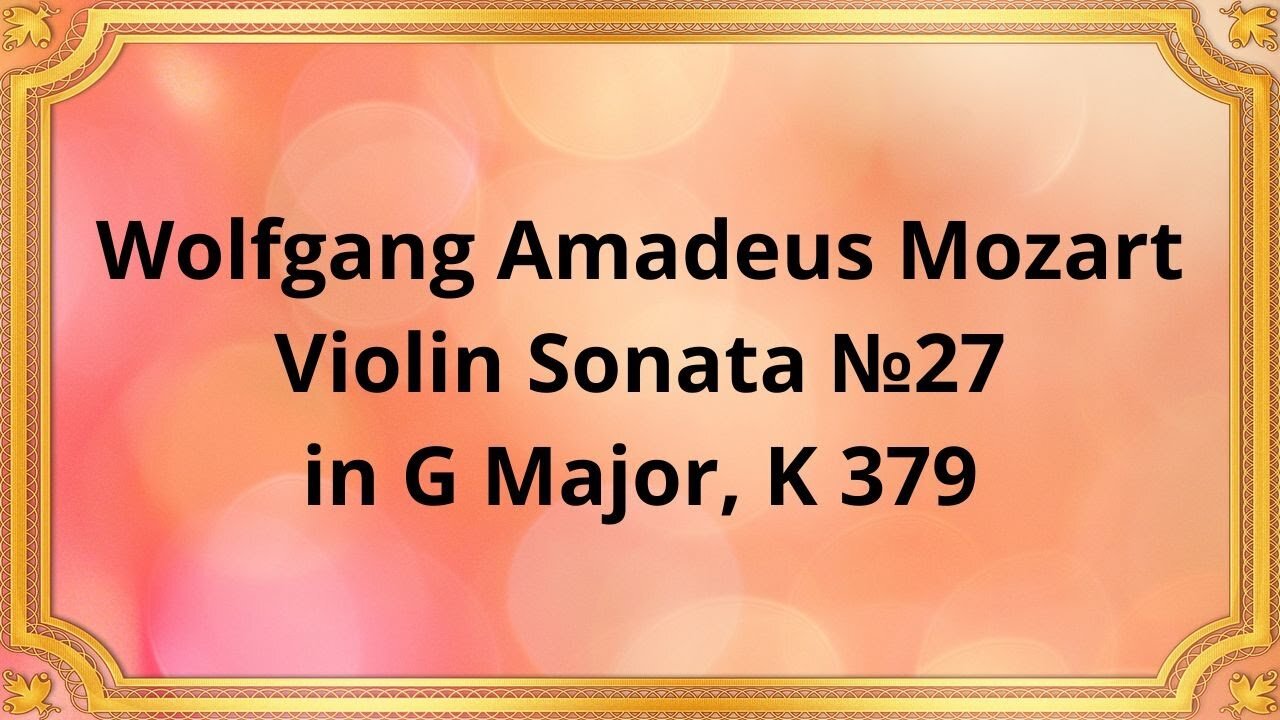Premium Only Content

Wolfgang Amadeus Mozart Violin Sonata №27 in G Major, K 379
#Mozart#Chamber_music#Classical_music#Violin_Sonata#Musical_composition
Publication date 1945
Alexander Schneider, violin; Ralph Kirkpatrick, harpsichord
Mozart's Violin Sonata No. 27 in G Major, K 379, is a brilliant example of the composer's genius in the violin sonata genre. Written in 1781, the sonata features a unique blend of technical virtuosity, expressive melodies, and rich harmonies that continue to captivate audiences and musicians today.
The sonata is structured in three movements, each with its distinct character and mood. The first movement is marked "Adagio - Allegro," and it opens with a slow and expressive melody that builds to a lively and joyful Allegro section. The second movement is marked "Theme and Variations," where Mozart takes a simple melody and transforms it into a range of musical expressions, from playful and light to introspective and somber. The final movement, marked "Allegro," is a fast and energetic piece that brings the sonata to an exhilarating conclusion.
Mozart's use of harmony and melody in this sonata is exceptional, highlighting his unique style and creativity. The sonata is written in G major, a bright and cheerful key that perfectly suits the piece's joyful and exuberant mood. The melodies are expressive and memorable, ranging from simple and elegant to complex and virtuosic. Mozart employs a range of harmonic techniques, from simple and beautiful to complex and daring, creating a rich and diverse sound world.
The sonata's technical demands are considerable, particularly for the violinist. The piece requires a high level of technical proficiency, including rapid finger work, challenging bowing techniques, and complex musical phrasing. Mozart's writing for the violin is highly idiomatic, showcasing the instrument's full range of expressive possibilities.
Mozart's Violin Sonata No. 27 in G Major, K 379, has had a significant impact on the development of the violin sonata genre. Its technical demands and expressive depth have inspired generations of violinists and composers, from Beethoven to Brahms. The sonata remains a popular and frequently performed work to this day, a testament to Mozart's enduring legacy as one of the greatest composers in history.
Conclusion:
Mozart's Violin Sonata No. 27 in G Major, K 379, is a masterpiece of musical composition, showcasing the composer's exceptional talent and skill. Its beautiful harmonies, intricate melodies, and technical demands make it a favorite of audiences and musicians alike. As a cornerstone of the violin sonata genre, the sonata remains a vital and influential work in the classical music canon, continuing to inspire and move audiences over two centuries after its creation.
-
 20:26
20:26
Classical music_Music Inspiration
1 month agoJohann Sebastian Bach Orchestral Suite No. 2 in B minor, BWV 1066
742 -
 LIVE
LIVE
The Bubba Army
21 hours agoGhislaine Maxwell: Ready to TALK?! - Bubba the Love Sponge® Show | 7/15/25
10,928 watching -
 LIVE
LIVE
FyrBorne
9 hours ago🔴Warzone M&K Sniping: Is The Overlook OP or Bait?
487 watching -
 2:00:53
2:00:53
MG Show
20 hours agoTrump Stops the Epstein Nonsense & Exposes FAKE MAGA; Victory Lap
67.3K59 -
 39:21
39:21
MattGaetz
1 day agoThe Anchormen Show with Matt Gaetz | Feeding the Dragon
22.7K20 -
 6:01
6:01
Michael Button
2 days ago $2.64 earnedMy History Degree Lied About Lost Civilizations
37.3K13 -
 9:36
9:36
MattMorseTV
1 day ago $3.84 earnedThe EU just FOUND OUT.
23.1K48 -
 22:39
22:39
Forrest Galante
1 day agoPrivate Tour of Australia's Craziest Zoo
149K13 -
 6:57:31
6:57:31
ABNERDAGREAT
9 hours ago🔴DISCORD VC/MUSIC ZELDA BREATH OF THE WILD SWITCH 2 EDITION🔴
4.96K1 -
 1:06:42
1:06:42
The Connect: With Johnny Mitchell
3 days ago $23.49 earnedTruth About The Epstein Files: CIA Agent Reveals The Connection Between The Mossad, Epstein, & Trump
77.3K84